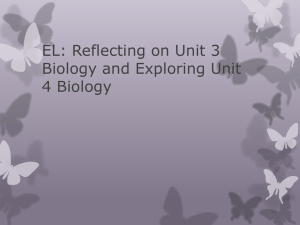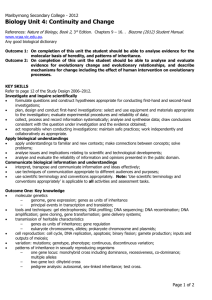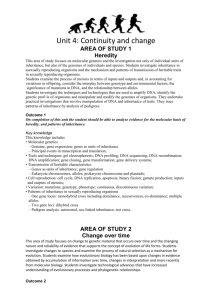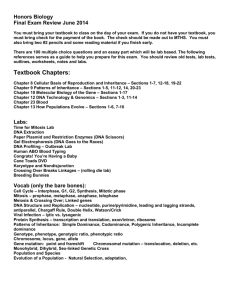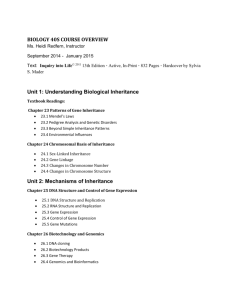BIOLOGY UNIT 4 Continuity & Change 2006 COURSE
advertisement
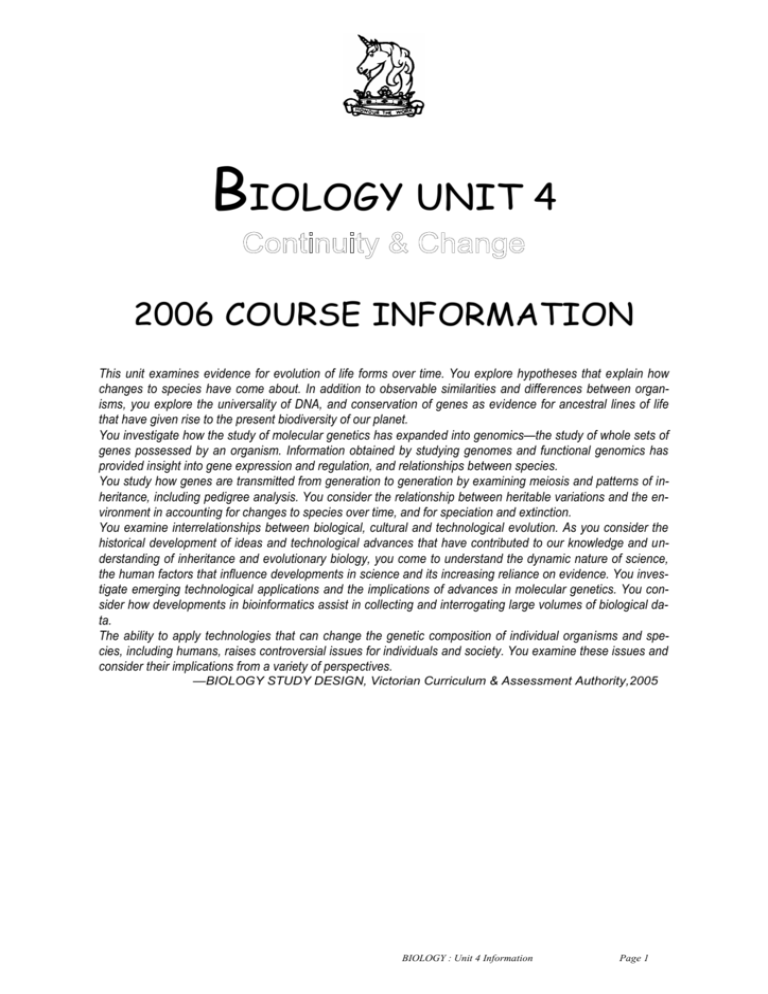
BIOLOGY UNIT 4 2006 COURSE INFORMATION This unit examines evidence for evolution of life forms over time. You explore hypotheses that explain how changes to species have come about. In addition to observable similarities and differences between organisms, you explore the universality of DNA, and conservation of genes as evidence for ancestral lines of life that have given rise to the present biodiversity of our planet. You investigate how the study of molecular genetics has expanded into genomics—the study of whole sets of genes possessed by an organism. Information obtained by studying genomes and functional genomics has provided insight into gene expression and regulation, and relationships between species. You study how genes are transmitted from generation to generation by examining meiosis and patterns of inheritance, including pedigree analysis. You consider the relationship between heritable variations and the environment in accounting for changes to species over time, and for speciation and extinction. You examine interrelationships between biological, cultural and technological evolution. As you consider the historical development of ideas and technological advances that have contributed to our knowledge and understanding of inheritance and evolutionary biology, you come to understand the dynamic nature of science, the human factors that influence developments in science and its increasing reliance on evidence. You investigate emerging technological applications and the implications of advances in molecular genetics. You consider how developments in bioinformatics assist in collecting and interrogating large volumes of biological data. The ability to apply technologies that can change the genetic composition of individual organisms and species, including humans, raises controversial issues for individuals and society. You examine these issues and consider their implications from a variety of perspectives. —BIOLOGY STUDY DESIGN, Victorian Curriculum & Assessment Authority,2005 BIOLOGY : Unit 4 Information Page 1 Unit 4 AREAS of STUDY 1 Heredity OUTCOME 1 You should be able to anylyse evidence for the molecular basis of heredity, and patterns of inheritance. This area of study focuses on molecular genetics and the investigation not only of individual units of inheritance, but also of the genomes of individuals and species. You investigate inheritance in asexually reproducing organisms and the mechanism and patterns of heritable traits in sexually reproducing organisms. You examine the process of meiosis in terms of inputs and outputs and, in accounting for variations in offspring, consider the interplay between genotype and environmental factors, the significance of mutations in DNA, and relationship between alleles. You investigate the techniques and technologies that are used to amplify DNA, identify the genetic profile of organisms and manipulate and modify the genomes of organisms. You undertake practical investigations that involve manipulation of DNA and inheritance of traits; you trace patterns of inheritance by anaylsis of pedigrees. Key knowledge for this Area of Study includes Molecular genetics genome, gene expression; genes as units of inheritance principal events in transcription and translation Tools and techniques: gel electrophoresis; DNA profiling; DNA sequencing; DNA recombination; DNA amplification; gene cloning; gene transformation; gene delivery systems Transmisson of heritable characteristics genes as units of inheritance; gene regulation eukaryotes chromosomes, alleles; prokaryote chromosome and plasmids 2 Cell reproduction: cell cycle, DNA replication, apoptosis; binary fission; gamete production; inputs and outputs of meiosis Variation: mutations; geneotype, phenotype; continuos, discontinuous variation patterns of inheritance in sexually reproducing organisms one gene locus: monohybrid cross including dominance, recessiveness, co-dominance; multiple alleles two gene loci: dihybrid cross pedigree analysis: autosomal, sex-linked inheritance; test cross. Change Over Time OUTCOME 2 On completion of this unit you should be able to evaluate evidence for evolutionary change and evolutionary relationships, and describe mechanisms for change including the effect of human intervention on evolutionary processes. This area of study focuses on change to genetic material that occurs over time and the changing nature and reliability of evidence that supports the concept of evolution of life forms. You investigate changes to species and examine the process of natural selection as a mechanism for evolution. You examine hoe evolutionary biology has been based upon changes in evidence obtained by accumulation of information over time, changes in interpretation and more recently from molecular biology. You investigate technological advances that have increased understanding of evolutionary processes and phylogenetic relationships. You consider how the interaction between human, cultural and technological evolution may have affected evolutionary processes. You also look at how applying reproductive and gene technologies to develop traits in species for particular purposes may affect evolutionary processes in the future. You consider the application of gene technologies to genetic screening and profiling of individuals and gene therapies that affect gene lines, and the bioethical, environmental and legal issues raised. Key knowledge for this Area of Study includes change in populations: gene pool, allele frequencies; selection pressures; genetic drift natural selection as a mechanism of evolution geological time: scale; relative and actual dating techniques evidence of evolution: fossil record, biogeography, comparative anatomy; molecular evidence patterns of evolution: divergent, convergent; allopatric speciation, extinction the development of evolutionary theory evolutionary relationships: conservation of genes; genome phylogeny; mitochondrial evolution hominid evolution: patterns, origin interrelationships between biological, cultural and technological evolution human intervention in evolutionary processes selective breeding application of gene technologies: cloning of organisms; transformations; stem cell differentiation; genetic screening, gene therapy SCHOOL-ASSESSED COURSEWORK The marking scheme for your School-Assessed Coursework (SAC) will be as follows. Notice the weighting given for each aspect of each criterion in each Task. For instruction relating to the Practical Exercises, see the separate Hand-out, MHS Unit 3 Practical Manual. At least 4 practical exercises must be completed, of which one should be (at least in part) of your own design. You must maintain a record of your practical work, including clear, concise reports of each exercise. You may work with one or two other students on the practical work, but the reports must be your own work. OUTCOME 1 Task 1 (Genetic Cross—Written Practical Report) Complex understanding of the theory of pedigree analysis. Complex understanding of the aims and methodology of the laboratory investigation. Detailed and accurate collection and presentation of results. Comprehensive and detailed analysis, evaluation and interpretation of the pattern of inheritance data. A comprehensive evaluation of the procedures of the practical investigation. Comprehensive and detailed knowledge of terms, concepts and understanding of the transmission of heritable characteristics. 21– 25 Thorough understanding of the theory of pedigree analysis. Thorough understanding of the aims and methodology of the laboratory investigation. Accurate collection and presentation of results. Thorough analysis, evaluation and interpretation of the pattern of inheritance data. A well-developed evaluation of the procedures of the practical investigation. Detailed knowledge of terms, concepts and understanding of the transmission of heritable characteristics. 16– 20 Mostly accurate understanding of the theory of pedigree analysis. Clear understanding of the aims and methodology of the laboratory investigation and collection and presentation of results. Mostly accurate analysis, evaluation and interpretation of the pattern of inheritance data. Identification and some evaluation of the procedures of the practical investigation. Mostly accurate knowledge of terms, concepts and understanding of the transmission of heritable characteristics. 11– 15 Some relevant discussion of the theory of pedigree analysis. Some relevant discussion of the aims and methodology of the laboratory investigation. Some accurate collection and presentation of results. Some knowledge and understanding of the pattern of inheritance data. Identification and some discussion of the procedures of the practical investigation. Some knowledge of terms, concepts and understanding of the transmission of heritable characteristics. 6– 10 Some reference to but little discussion of the theory of pedigree analysis. Some identification of the aims and methodology of the laboratory investigation. Presentation of results may be inaccurate. Knowledge and understanding of the pattern of inheritance data is unclear. Some reference to the procedures of the practical investigation. Limited knowledge of terms, concepts and understanding of the transmission of heritable characteristics. 1–5 Task 2 (DNA Manipulation — Practical Report) Complex understanding of the tools and techniques used to study DNA at the molecular level. Complex understanding of the aims and methodology of the laboratory investigation. Detailed and accurate collection and presentation of results. Comprehensive and detailed analysis, evaluation and interpretation of the results. A comprehensive evaluation of the procedures of the practical investigation. Comprehensive and detailed knowledge of terms, concepts and understanding of the structure of DNA and how to manipulate this structure for specified purposes. 21– 25 Thorough understanding of the tools and techniques used to study DNA at the molecular level. Thorough understanding of the aims and methodology of the laboratory investigation. Thorough collection and presentation of results. Detailed analysis, evaluation and interpretation of the results. A well-developed evaluation of the procedures of the practical investigation. Detailed knowledge of terms, concepts and understanding of the structure of DNA and how to manipulate this structure for specified purposes. 16– 20 Mostly accurate understanding of the tools and techniques used to study DNA at the molecular level. Clear understanding of the aims and methodology of the laboratory investigation. Mostly accurate collection of results and clear and relevant presentation of results. Mostly accurate analysis, evaluation and interpretation of the results. Identification and some evaluation of the procedures of the practical investigation. Mostly accurate knowledge of terms, concepts and understanding of the structure of DNA and how to manipulate this structure for specified purposes. 11– 15 Some relevant discussion of the tools and techniques used to study DNA at the molecular level. Some relevant discussion of the aims and methodology of the laboratory investigation. Collection and presentation of results may be inaccurate although some knowledge and understanding is indicated. Identification and some discussion of the procedures of the practical investigation. Some knowledge of terms, concepts and understanding of the structure of DNA and how to manipulate this structure for specified purposes. 6– 10 Brief reference to but little or no discussion of the tools and techniques used to study DNA at the molecular level. Some description of the aims and methodology of the laboratory investigation but presentation of results is limited. Brief discussion of the results and or the procedures of the practical investigation. Knowledge of terms, concepts and understanding of the structure of DNA and how to manipulate this structure for specified purposes is unclear. 1–5 OUTCOME 2 Task 1 (Evolutionary Relationships— Report) Complex understanding of the theory of natural selection. Complex and detailed understanding of the aims and methodology of the investigation. Comprehensive and detailed analysis, evaluation and interpretation of the data. A comprehensive evaluation of the procedures of the practical investigation. Comprehensive and detailed knowledge of terms, concepts and understanding of evolutionary relationships. 21– 25 Thorough understanding of the theory of natural selection. Thorough and detailed understanding of the aims and methodology of the investigation. Detailed analysis, evaluation and interpretation of the data. Detailed evaluation of the procedures of the practical investigation. Detailed knowledge of terms, concepts and understanding of evolutionary relationships. 16– 20 Mostly accurate understanding of the theory of natural selection. Mostly accurate explanation of the aims and methodology of the investigation. Some detailed analysis, evaluation and interpretation of the data. Identification and some evaluation of the procedures of the practical investigation. Some detailed knowledge of terms, concepts and understanding of evolutionary relationships. 11– 15 Some understanding of the theory of natural selection. Some relevant discussion of the aims and methodology of the investigation. Some knowledge and understanding of the data. Identification and discussion of the procedures of the practical investigation. Some knowledge of terms, concepts and understanding of evolutionary relationships is demonstrated. 6– 10 Some reference to the theory of natural selection. Some reference to the aims and methodology of the investigation. Knowledge and understanding of the data is unclear. Identification and some description of the procedures of the practical investigation. Uses some terms and concepts and refers to evolutionary relationships but limited understanding is demonstrated. 1–5 Task 2(Response to a Gene Technology Issue—Web-page) Comprehensive and detailed knowledge of the evolutionary process. Critical evaluation of the impact on evolution by humans. Critical evaluation of the reasons for human intervention in evolutionary processes. Comprehensive understanding of the interrelationships between biological, cultural and technological evolution. Comprehensive understanding of the issue. Critical evaluation of the reliability of the information and opinions expressed. Comprehensive and relevant application of appropriate scientific terminology and conventions. The response reflects a very high level of ability to communicate information and understanding to the intended audience. 21– 25 Thorough knowledge of the evolutionary process. Detailed evaluation of the impact on evolution by humans. Detailed and relevant evaluation of the reasons for human intervention in evolutionary processes. Thorough understanding of the interrelationships between biological, cultural and technological evolution. Detailed and relevant understanding of the issue. Thorough evaluation of the reliability of the information and opinions expressed. Detailed and relevant application of appropriate scientific terminology and conventions. The response reflects a high level of ability to communicate information and understanding to the intended audience. 16– 20 General knowledge of the evolutionary process. Some evaluation of the impact on evolution by humans. Some relevant evaluation of the reasons for human intervention in evolutionary processes. Mostly detailed understanding of the interrelationships between biological, cultural and technological evolution. Mostly relevant understanding of the issue. Some evaluation of the reliability of the information and opinions expressed. Mostly relevant application of appropriate scientific terminology and conventions. The response reflects an ability to communicate most information and understanding to the intended audience. 11– 15 Some knowledge of the evolutionary process. Some explanation of the impact on evolution by humans. Some evaluation of the reasons for human intervention in evolutionary processes. Some understanding of the interrelationships between biological, cultural and technological evolution. Some understanding of the issue is relevant. Limited discussion of the reliability of the information and opinions expressed. Some relevant application of appropriate scientific terminology and conventions. The response shows some ability to communicate information and understanding to the intended audience. 6– 10 Limited knowledge of the evolutionary process. Some description of the impact on evolution by humans. Some explanation of the reasons for human intervention in evolutionary processes. Limited understanding of the interrelationships between biological, cultural and technological evolution. Understanding of the issue is not clear. Little discussion of the reliability of the information and opinions expressed. Limited applications of appropriate scientific terminology and conventions. The response may be unclear in its communication of information and understanding to the intended audience. 1–5 UNIT 4 SAC ASSESSMENT CRITERIA SAC 1–1 Mendelian Inheritance (Barley Monohybrid Cross) Collection & presentation of results Evaluation of procedures and results Understanding of Mendelian inheritance theory Ability to interpret pedigrees 7 8 5 5 SAC 1–2 DNA Manipulation (GTAC) Knowledge of the structure of DNA Knowledge of the procedures used in DNA manipulation Presentation of results Interpretation of results of the manipulation procedures used 5 7 5 8 SAC 2–1 Evolutionary Relationships (Galapagos Finches) Knowledge of the relevance of the data presented to the evolution suggested by the data Indication of the techniques used to study the evolution suggested by the data Indication and explanation of the types of evolution suggested by the data, and the species involved Indication of the relationships between the abiotic and biotic factors influencing the species involved 8 5 8 5 SAC 2–2 Response to an Issue Related to Applied Gene Technology Understanding the impact of the issue on the evolutionary process Understanding the reason(s) for human intervention Evaluation of arguments relating to the issue Skill in communication of information 6 8 6 5 Unit 4 SAC Outcomes will be reported to VCAA as a mark out of 100 and will contribute 17% to your final assessment; 33% will be contributed by your end-of-year examination. SAC 2–1—Report: Evolutionary Relationships After viewing the video program Islands of the Vampire Birds, complete a report of about 1000 words in which you investigate aspects of evolution in the various finch species on the Galápagos Islands, in a way that demonstrates a sophisticated level of understanding of the mechanisms and processes of evolution, and addresses all assessment criteria shown above. Be careful to use the correct names of investigators (attribution) and their investigation methods, species involved [including scientific names] and relevant islands, events and dates mentioned in the video. Please prepare your report in Comic Sans MS 10 point font. ASSESSMENT The award of satisfactory completion is based on a decision that you have demonstrated achievement of the outcomes. This decision will be based on your teacher’s assessment of your overall performance on assessment tasks designated for the Unit. The Key Knowledge listed on page 2. Achievement will be assessed on school-assessed coursework (SACs—see page 3), and a mid-year examination. SACs will contribute 17% to the study score; the examination will contribute 33%. There will be four SACs, each marked out of 25. Be sure to take account of the assessment criteria shown on page 4. END-of-YEAR EXAMINATION You will have to answer a series of questions set by an examination panel. All of the key knowledge that underpins the outcomes in Unit 3, and the set of skills on page are examinable. There will be 25 Multplie-choice questions, worth 1 mark each. There will be a number of extended-response questions worth a total of 50 marks. The kinds of questions will requie you to apply understanding of concepts and processes to unfamiliar situations analyse the relationship of data to concepts and principles evaluate experimental procedures solve problems or make predictions or judgements based on the synthesis of a number of ideas. The task will be a 1½-hour exam, which will contribute 33% to your final Biology Study Score. DEADLINES These dates for submission of SAC practical reports are tentative. Precise dates will be notified when they are known, as will dates for the actual work involved in each SAC. Generally, the dates for the practical part of SACs will correspond to your scheduled double period. * SAC 1–1 (Genetic Cross prac report) f/b 17 July * SAC 1–2 (DNA Manipulation prac report) f/b 24 July * SAC 2–1 (Evolutionary Relationships report) f/b 4 Sep * SAC 2–2 (Response to a Gene Technology Issue) 6 Oct
